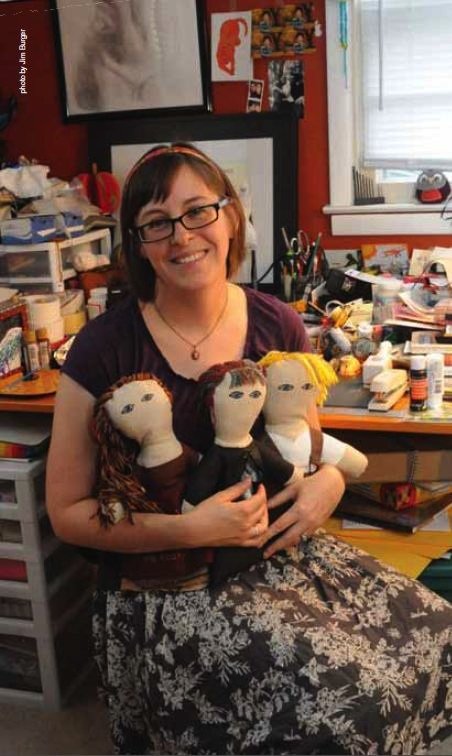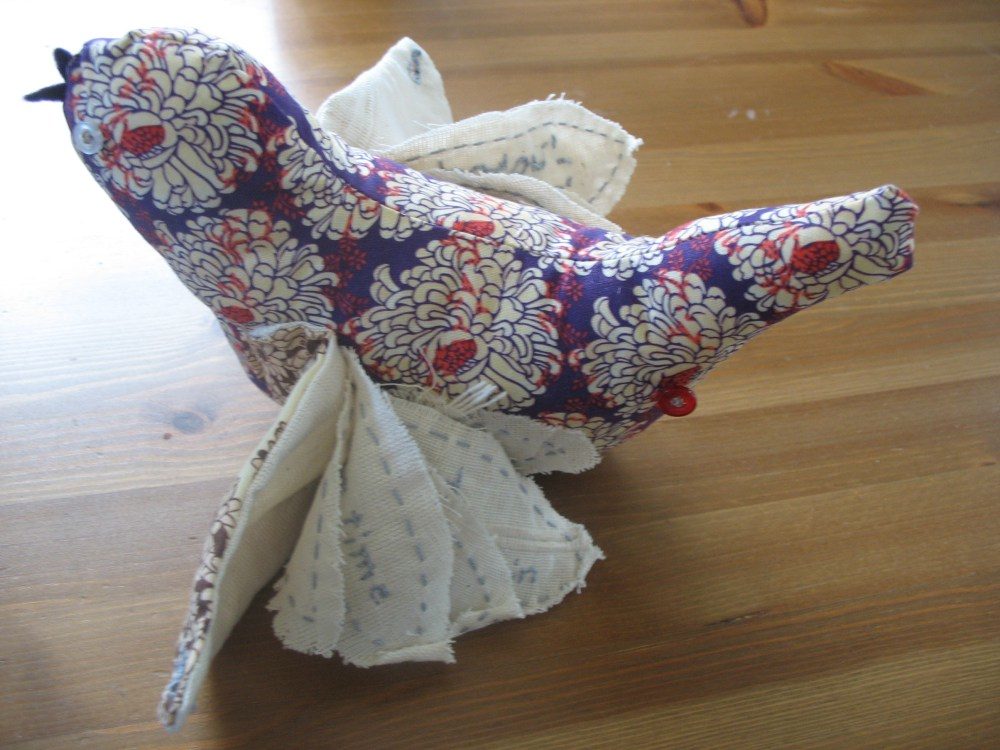Background Text
MAGAZINE ARTICLE
Linell Smith, “The Art of Poetry” From Goucher Quarterly, Winter 2014
This article from the Goucher Quarterly, the alumni magazine of Goucher College, profiles alumna and artist Jenny O’Grady. As you read the article, note how writer Linell Smith mixes concrete fact—


A quick, vibrant visual description opens the piece. |
Jenny Huddleston O'Grady ‘98 writes poems you can undress and poems you can press to your heart. One, written on a shiny fabric eel, can wind around a little finger. Another flutters if you read it out loud. She's even composed a haiku you can wear. Imagine a poem stitched into the skirts of a doll, or hidden in a tiny typewriter, nestled underneath a bird's wing, or etched into the gills of a horseshoe crab. You might say the 37-year-old artist proves how essential poetry is by uncovering the various shapes it can assume. |

A witty punchline or verbal pun casts a mood. |
You might also say she liberates it. "Some people really want to see their words in a certain way and in a certain order. They like to control their writing," she observes. "I don't care. I like interactivity. If someone reads the poem wrong, it really doesn't matter to me. If you play around with it, you're still going to get a sense of it." |

Mentions of the artist's accolades from various organizations. |
And, in the process, you might never forget it. Some of these award-winning "poem sculptures" were recently displayed in a gallery in Baltimore's Station North, the city's artistic hub near the Maryland Institute College of Art (MICA). O'Grady's work was part of an exhibition that featured nine artists who were awarded $1,000 "b-grants" last year by the Greater Baltimore Cultural Alliance (GBCA) for artistic excellence and innovation. Her work received an additional $500 grant honoring the late GBCA founder, Nancy Haragan. |

Quote from a fellow artist continues to praise O'Grady's work. |
"Jenny O'Grady creates timeless fabric sculptures that incorporate poems reminiscent of her favorite books or memories," says Emily Russell, a MICA graduate student who helped curate the show. "She combines traditional art forms like poetry, sewing, and bookbinding in a nontraditional way, and I think that is why her work is so unique and fun." It's also a tribute to what this artist and writer can accomplish in the cracks between her job as marketing director for the University of Maryland, Baltimore County (UMBC), and her home life with her husband, T.J. O'Grady ‘99, and their 5-year-old son, Max. In addition to her handmade literary works, O'Grady founded and edits The Light Ekphrastic, a quarterly online journal that pairs writers and visual artists to create new pieces based on one another's work. The four-year-old journal hosted its first non-virtual exhibition at a Baltimore-area gallery last year. During the work week she turns out innovative, attention-grabbing pieces for the alumni relations and development department of UMBC, and, until last year, taught book arts and electronic publishing at the University of Baltimore. |

The writer adds some history, showing how the artist developed over time. |
Growing up in a family of artists—her sister went to MICA, her mother began an art appreciation program at her elementary school—O'Grady says she never considered herself particularly artistic. "Super shy," she longed to become a community newspaper reporter like her mother, who worked for a weekly in Denton, Md. She did. And you might say that several years of reporting, combined with the perspective of an Eastern Shore farm girl, helped mold her fresh, outsider's vision. A diet of liberal arts at Goucher, she says, also proved invaluable. "It helped me to not only write clearly but to understand context—to understand enough of history, and of what has happened before me, to write convincingly," she says. An English major, she also served as editor of The Quindecim. After graduation, O'Grady worked for The Evening Sun in Hanover, Pa., and then for The Maryland Gazette. Covering fires and town meetings, she also learned how to capture the flavor of local feature stories about "ballroom" boxing or an unusual piglet raised on cans of chocolate Ensure. Along the way, she sharpened her visual skills by taking night courses in photography, graphic design, and drawing. |

A quote from O'Grady describes how she encourages friends (and by extension, readers) to express themselves artistically. |
She enrolled in the University of Baltimore in 2002 and graduated with her M.F.A. in creative writing and publishing arts four years later. By that time she was working at UMBC, where she began persuading artist and writer friends not to allow their day jobs to constrain them. "I like to consider myself an artistic nag," she says. "I work with a lot of graphic designers who love to paint or draw but don't feel like they have time. So I said, ‘Well, what if I gave you each a poem? Would the guilt of that get you going? Would the inspiration of that get you going?'" The next step was designing a website, The Light Ekphrastic, to display their work. Ekphrasis is a rhetorical device in which an artist in one medium tries to relate to the work of another artist by defining and describing its essence and form. A painting can describe a sculpture, a poem can portray a picture, and vice versa. "It's reactive, a jumping-off point," O'Grady says. As a young girl she relished "choose your own adventure" books in which readers made choices that determine how the story develops. Now she's passing on the pleasures of reading interactively to young Max. Perhaps her most child-friendly poem is "Homing." The plump cloth bird that carries her words also captures the spirit of the O'Gradys' 2009 trip to South Korea to adopt their son. |

An explanation of the personal motivation for one piece, which is reproduced below. |
"It's based on the idea of migration," she says. "I wanted to write a poem that you could read backward and forward like the trip, and I wanted you to be able to turn it over in your hands. Then I realized that a bird's wings would make really cool pages." Constructed in stolen moments during her maternity leave, the poem is made completely of fabric, with hand-embroidered text. The feathers, or "pages," fasten to the body of the bird with red buttons. When opened, they reveal the poem that reads forward and backward, depending on which side of the bird you're on: |
|
north says it is time all that you own tucked neatly within homing south says south says it is time all that you own tucked neatly within homing north says |
|
|
Sometimes O'Grady is drawn to troubling subjects. Take, for instance, her award-winning trio of poem dolls, each based on a character from Gunter Grass' dark novel The Tin Drum. |
|

Explanations of the motivations behind some of the work. |
"I've tried to make the physical experience of reading each poem doll mirror an aspect of the doll's character, and also somewhat intrusive—as each poem touches on private, uncomfortable moments of their lives. You must lift a skirt, or unzip a dress, or unbutton suspenders to read their stories," she explains on her website, www.kineticprose.com. |

A URL allows readers to find additional information. |
You can also consider such work—constructed from eyelet-driven hinges, recycled paper bags, Shrinky Dinks, and Mod Podge—as a marriage between literary inspiration and the do-it-yourself world of Michaels crafts. It's got a roll-up-your-sleeves magic. When O'Grady teaches bookmaking, she works hard to demystify the challenge posed by the blank page. "A lot of people write, write, write, but they are not makers," she says. "I try to force them in the same way that a live drawing block_type forces you out of your comfort zone. Sometimes I make my students rip up part of their book so that they don't feel like it's such a sacred thing. They can destroy it," she points out. "And then they can make another one." |
